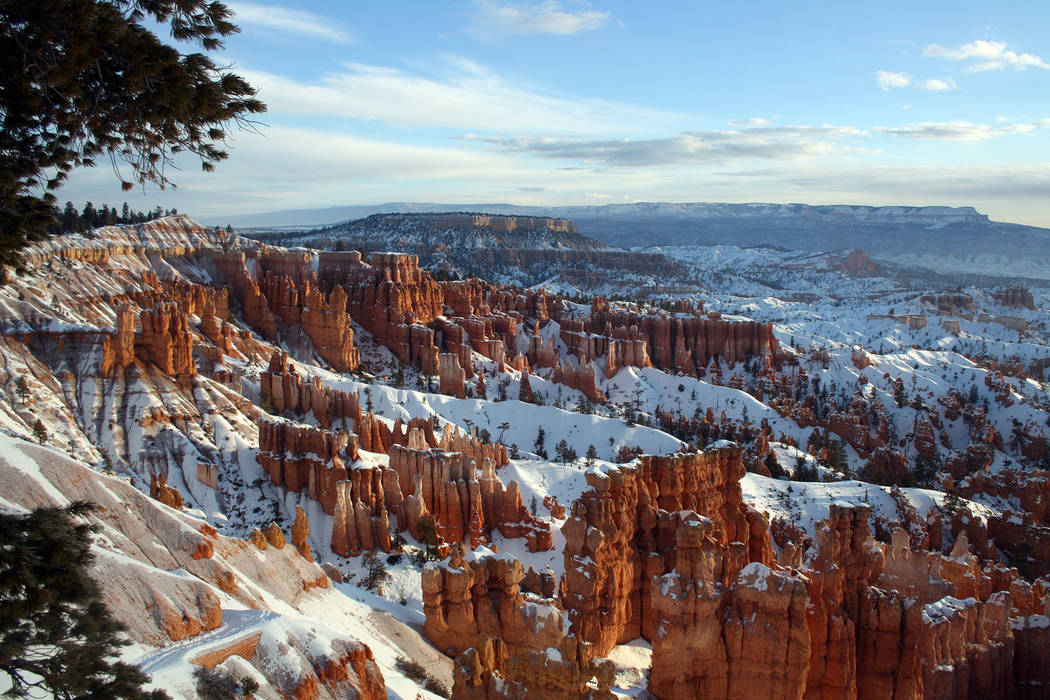
Bryce Canyon National Park is an extraordinary place any time of year, but in winter it’s even more magnificent, yet more affordable.
While the park is called a canyon, it is actually made up of 12 natural amphitheaters on the eastern escarpment of the Paunsaugunt Plateau in southwestern Utah. In these natural steep and wide gullies there are spires and pinnacles of red, orange and pink limestone that have been carved into fantastic shapes by frost wedging.
This form of erosion takes place during the 200 or so winter days when temperatures alternate between freezing and thawing. Thawing allows water to fill cracks in the rock; it freezes that night and wedges the crack a little more open. After many repetitions, a piece of rock will fall away. The remaining shapes suggest grotesque living beings. To some imaginations they seemed scary and thus were named “hoodoos.”
Most visitors here come from late spring to fall, but if you go in winter, you’ll have some added treats. With snow, the hoodoos’ colors seem more vibrant and you can cross-country ski, snowshoe and take part in other winter activities. Winter lodging rates are more affordable and you won’t encounter crowds at the overlooks or on trails.
The average snowfall in January and February is 17 inches, with March receiving about 15 inches. Elevations in the park range from 8,000 to 9,115 feet. During January and February you can expect average high temperatures in the 30s dipping down into the mid-teens overnight. Be forewarned though, low temperatures can be much colder. On a couple of occasions, I’ve experienced overnight lows here in the negative 20s. Brrrrrr.
The park has a 7.4-magnitude night sky, which means on a clear, moonless night you could possibly see 7,500 stars. On a clear day, from many of the viewpoints, you can see about 100 miles.
The 35th annual Bryce Canyon Winter Festival takes place Presidents Day Weekend, Feb. 15-17. This event features free clinics; demonstrations; and tours and ranger programs, both indoors and outdoors, with some suitable for all ages. Highlights include ski and archery clinics and serious competitions, such as an archery biathlon and cross-country ski races, but some contests are just for fun, such as the Kids’ Snow Boot Races.
Most of the festival takes place in or surrounding Ruby’s Inn just outside the park’s entrance, but there are a few great programs in the park itself, such as stargazing with telescopes and geology talks. For a full schedule of events for all venues contact, 866-866-6616 or visit http://www.rubysinn.com/bryce-canyon-winter-festival.
The visitor center is the place to start any visit. Its exhibits range from geology to wildlife to prehistoric culture, and there is a fine book and gift store. Be sure to inquire about trail conditions, pick up some maps or learn about their winter ranger programs.
One such program, snow and weather permitting, is the Bryce Canyon Snowshoe Program, a ranger-guided outing to introduce the winter wonders of the park. This usually lasts about two hours and they will also outfit you with snowshoes and poles. You must provide your own snow boots or waterproof hiking boots, gloves, hats and appropriate warm winter clothing.
In general, it’s a good idea to have traction devices that easily slip onto your boots; they are needed for walking on the snowy and icy trails or even visiting the viewpoints. Most outdoor stores in the Las Vegas area sell them, but you can usually pick them up at Ruby’s Inn General store or at the visitor center. I found that Yaktrax and STABILicers brands work well on ice and snow.
If you didn’t pack your own outdoor skis or snowshoes but want to head out on your own on some of the groomed trails, head over to Ruby’s Inn Adventure Center and they will fix you up. Of course, be sure to bring your own personal outdoor winter clothing, but you can easily get outfitted with skis, poles, snowshoes or skates for their ice rink.
Be aware, after major winter storms the 18-mile scenic drive main road could possibly be closed from mile 3 for one to two days to remove snow. Also, some trails remain closed for the season due to steep and dangerous conditions; these include the popular Wall Street and the Rim Trail from Bryce Point to Inspiration Point. In winter, Fairyland Point Road and Paria View Roads are only open to human-powered winter activities such as cross-country skiing or snowshoeing.
While the park is open 24/7, year-round, the Bryce Canyon Visitor Center is open daily 8 a.m. to 4:30 p.m., with extended hours from spring through fall. It is closed Christmas and New Year’s Day. Contact the Bryce Canyon Visitor Center at 435-834-5322 or visit http://www.nps.gov/brca.
Good options for lodging are Best Western Ruby’s Inn (866-866-6616 or http://www.rubysinn.com) and Bryce View Lodge (888- 279-2304 or http://www.bryceviewlodge.com).
Many of Deborah Wall’s columns have been compiled into books about hiking in the Southwest. She is also the author of “Great Hikes, a Cerca Country Guide” and a co-author of the book “Access For All, Seeing the Southwest With Limited Mobility.” Wall can be reached at Deborabus@aol.com.